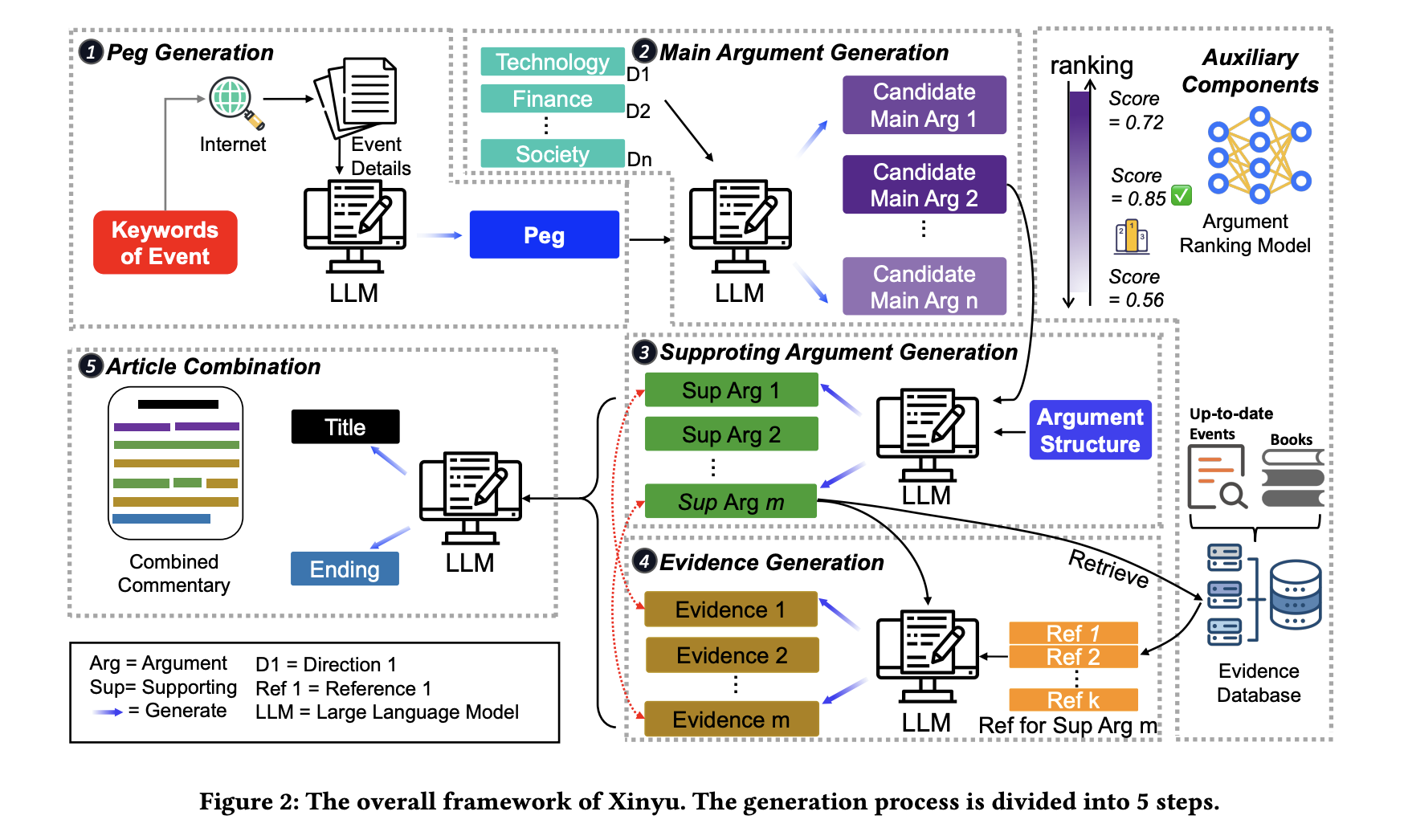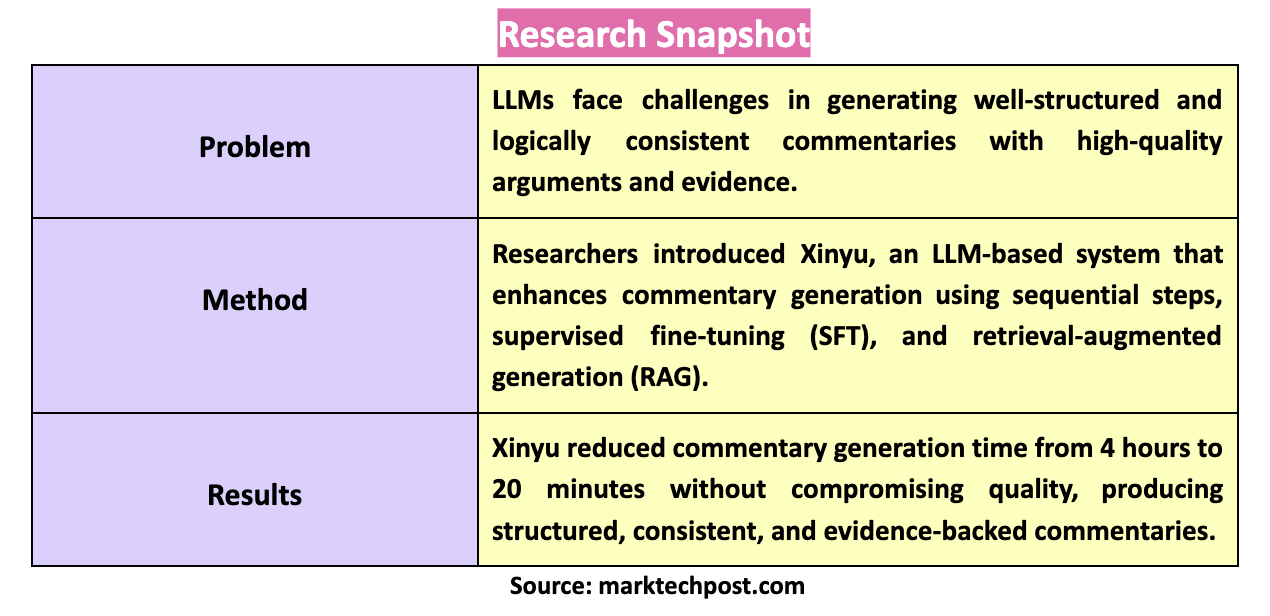

Large language models (LLMs), characterized by their advanced text generation capabilities, have found applications in diverse areas such as education, healthcare, and legal services. LLMs facilitate the creation of coherent and contextually relevant content, allowing professionals to generate structured narratives with compelling arguments. Their adaptability across various tasks with minimal input has rendered them essential tools in producing high-quality, domain-specific content, especially in environments that demand precision and consistency in textual outputs.
One of the critical challenges facing NLP, particularly in commentary generation, is the need for models to meet specific and often complex requirements. While LLMs have simplified many aspects of text generation, their direct application in creating commentaries has proven challenging. The primary issue lies in fulfilling the dual demands of producing well-structured narratives and generating original, high-quality arguments supported by convincing evidence. This duality is crucial for commentaries, where the quality of the argumentation and the reliability of the evidence presented are paramount. The task is further complicated by the need for these models to maintain efficiency without compromising on the depth and relevance of the content. This balance is difficult to achieve with existing generative approaches.
Existing methods for generating commentaries often rely on traditional metrics like ROUGE and BLEU, which measure the similarity of the generated content to reference texts. However, more than these metrics are needed for evaluating a commentary’s overall quality, particularly regarding structural soundness and logical consistency. Despite their proficiency in generating fluent text, LLMs frequently need help to maintain coherence and ensure the quality of arguments, leading to outputs that, while readable, may require more depth and rigor for effective commentary. This limitation highlights the need for more sophisticated approaches to address the commentary generation’s unique requirements better.
Researchers from Zhejiang University, the Institute for Advanced Algorithms Research, Northeastern University, the State Key Laboratory of Media Convergence Production Technology and Systems, and the Research Institute of China Telecom have developed Xinyu, an innovative system designed to improve the efficiency and quality of Chinese commentary generation. Xinyu leverages the power of LLMs but goes beyond traditional methods by decomposing the commentary generation process into a series of sequential steps. This approach allows the system to address the task’s fundamental and advanced requirements effectively. Supervised fine-tuning (SFT) and retrieval-augmented generation (RAG) technologies are integral to Xinyu’s design, enabling the system to generate well-structured and logically consistent narratives while producing high-quality, evidence-backed arguments.
The technical methodology employed by Xinyu involves several distinct components. The process begins with peg generation, which summarizes event details swiftly and accurately, forming the basis for the subsequent steps. The system generates the main argument, supporting arguments, and relevant evidence. Each step is meticulously fine-tuned to ensure the generated content is coherent and logically aligned with the initial peg and the narrative structure. A key feature of Xinyu is its argument ranking model, which scores and ranks candidate arguments based on their novelty and objectivity, ensuring that the most compelling arguments are prioritized. Xinyu incorporates an evidence database, which includes up-to-date information from events and classic literature, to support the generation of accurate and contextually relevant evidence.
The system has dramatically reduced the time required for commentators to generate a full commentary from an average of four hours to just 20 minutes. This tenfold increase in efficiency does not come at the expense of quality. On the contrary, the commentaries generated by Xinyu meet high standards of structure, logic, and evidentiary support, as evidenced by comprehensive evaluation metrics that consider these dimensions. The system’s ability to produce high-quality content at such a rapid pace demonstrates its potential to revolutionize commentary generation, particularly in fields where timeliness and accuracy are crucial.

In conclusion, the development of Xinyu addresses the unique challenges of commentary generation. Xinyu not only enhances the efficiency of the process but also ensures that the output remains of high quality, with well-structured arguments supported by robust evidence. The system’s success in reducing the time required for commentary generation while maintaining or even improving the quality of the content highlights its potential as a valuable tool for professionals in various domains. Xinyu represents a promising step forward in the ongoing effort to harness the power of NLP for more sophisticated and impactful applications.
Check out the Paper. All credit for this research goes to the researchers of this project. Also, don’t forget to follow us on Twitter and join our Telegram Channel and LinkedIn Group. If you like our work, you will love our newsletter..
Don’t Forget to join our 49k+ ML SubReddit
Find Upcoming AI Webinars here
The post Xinyu: Transforming Commentary Generation with Advanced LLM Techniques, Achieving Unprecedented Efficiency and Quality in Structured Narrative Creation appeared first on MarkTechPost.